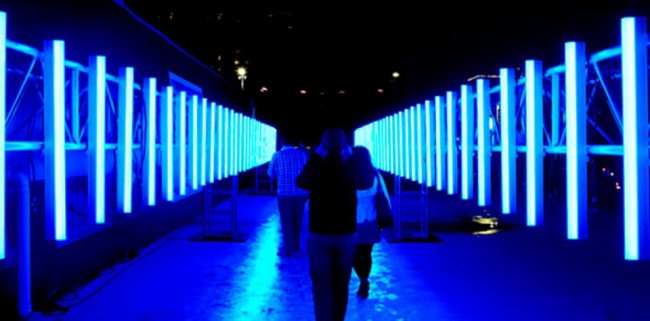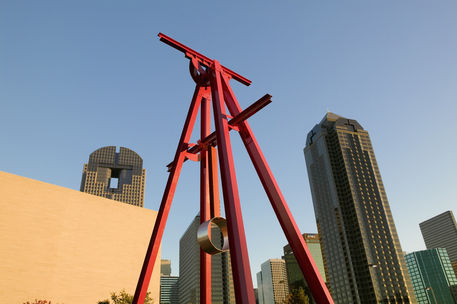
Dallas’ unpredictable icy winter weather left many travelers stranded at Dallas Love Field airport this weekend, but it was not the worst thing considering the two new public art exhibits on display. A highly engineered scaffold with colorful, rectangular aluminum beams forming a gateway arch and giant illuminated metal lanterns cut with a pattern symbolizing the aspect of flight, make up the installs in the airport’s entrance and exterior.
Thanks to the Love Field Art Program, Tom Orr’s Intersected Passage and Diana Goldberg and Julie Cohn’s Luminara were installed on Dec. 4.Public art has been a part of Dallas Love Field since 1961, but since the 2009 renovations the airport has seriously incorporated public art into its design. These displays are just another example of the public art movement across Dallas.
“Public art is a critical experience in any city because it inspires people to moves by art and be part of their day-to-day life,” said Director of Meadows Museum, Dr. Mark A. Roglán.
In Dallas, public art has numerous manifestations. As is true for many major cities in the United States, art is commissioned to be in public spaces by municipalities, arts commissions, non-profit organizations and private enterprises. Public art, which was once dominated by famous sculptors working on a much grander scale, has become increasingly interactive and integrated into the cityscape. The change is in the social practice. It is engaging communities and creating change through art that is thought provoking while aesthetically pleasing.
“Some of the major trends are about place making or the creation of vibrant public spaces where people can gather, environmental issues, health initiatives, and public art at airport, including our own Dallas Love Field has expanded significantly,” said Kay Kallos, public art program manager at the office of cultural affairs in Dallas.
Jack Becker, chief editor of Public Art Review, said there is no singular trend in public art.
“The Dallas public art scene consists of public and private endeavors and each has its own following. It’s good to have this diversity of approach and engagement,” said Kallos.
The city of Dallas has supported public art through its art program since 1988, however, many of Dallas’ well-known public art works, such as the Henry Moore-the Dallas Piece at City Hall Plaza, were donated prior to the initiation of the public art ordinance. Donated works of art continue to be a part of the city’s public art program; 28 works have been accepted into the Public Art Collection since 1989.
“I think the Mark di Suvero sculpture, Proverb, looks great close to the symphony and the recent construction of the opera, theater, etc, have brought tremendous energy to our city,” said Dr. Roglán. The sculpture makes a statement with its tall bright red iron rods in the shape of a pendulum placed on the lawn in front of the Dallas Symphony.
Over the last 10 years there has been an increased interest in public art in Dallas, evidenced by the number of works commissioned and the press coverage. Growing partnerships feature recent works such as Aurora, which brought numerous international artists and spectators to Dallas. This brought international attention and recognition of the possibilities Dallas has to have to have a reputable art scene. The event also brought Dallas together for a chance to collaborate and engage within the community.
“I think that the public art scene in Dallas is definitely growing. Just by looking at the attendance of Aurora (over 30,000 people attended) shows that there is a bright future for the art scene in Dallas,” said Katya Deahl, fulfillment associate at Speakeasy digital marketing in Dallas.
The free contemporary art exhibition was centered in the rapidly developing Dallas Arts District in October. Light, sound, interactive artwork, video, and live performances were presented in unexpected ways.
“My favorite part of the event was when the Wyly Theatre lit up. Not only was the building glowing, but it also illuminated downtown and the idea for Dallas to have a bigger art presence,” said Deahl.
Aurora was modeled after all-night events known as “Nuit Blanche,” which has been enticing visitors in North America since 2006. The Toronto event is probably the most important precursor for the United States. Many similar events began in European cities in the 1990s and spread throughout North America.
“Aurora brought a lot of international artists and spectators to Dallas, which helped bring international attention and recognition to the possibilities Dallas has to have a reputable art scene. It also brought the community of Dallas together for a chance to collaborate and engage within their community,” said Deahl.
“Nuit Blanche” was originally conceived in Paris, France in 2002, in an attempt to bring contemporary art to the masses in public spaces. Now universally translated as ‘Sleepless Night’, has expanded its reach beyond Paris to more than 25 cities across the globe-each offering its own version of the all-night art extravaganza. Toronto was the first North American city to fully replicate the Paris model, and has inspired similar celebrations throughout North America, including San Francisco, New York, Miami and Chicago.
“Aurora is an important development in temporary art events that are accessible to the general public. After three years it is now making significant contributions to the Dallas art scene. Dallas will certainly benefit from Aurora’s lead into temporary art events, which enliven other cities,” said Kallos.
One of the most powerful aspects of public art is its ability to become a tool for community engagement. No matter where it is, public art brings people together in unexpected ways in unexpected places. It happens upon people, therefore unintentionally yet intentionally, art is instilled into the general public whether people are looking for thought provoking or aesthetically pleasing engagement through art
“I love Centennial Park in Chicago, a city that continues rethinking and coming out with terrific artistic solutions for their public spaces. I also think Santiago Calatrava’s bridge has brought great design to our city and it blends beauty and function,” said Dr. Roglán.
Calatrava’s bridge, better known as the Margaret Hunt Hill Bridge, is the 40-story large steel arch providing an elegant gateway to West Dallas along with an additional feature to the Dallas skyline. The bridge is squarely at the intersection where art and function meet. Come to it in one frame of mind and leave in another. On the morning of March 28, 2010, a man riding a Vespa officially led traffic across the bridge to open it. Thousands had already walked across the bridge during a handful of events commemorating the bridge early that month.
Public art brings beauty to an environment by uplifting dreary corridors or serving as a badge for a community. However, it can also serve as a catalyst for community and economic development. Some would say public art is no different than what someone would find in a museum, but it combines art with creative place making and social practice.
“The public art scene, in Dallas, has been increasing greatly these last years and it is poised to continue growing thanks to the support of so many art patrons,” said Dr. Roglán.












